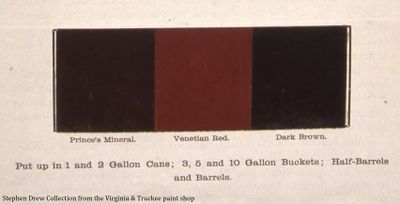Difference between revisions of "Rio Grande Western Railway: Paint Information"
Josh Bernard (talk | contribs) (Added info about business car nomad being repainted to Tuscan in 1899) |
Josh Bernard (talk | contribs) |
||
| Line 44: | Line 44: | ||
'''1889''' | '''1889''' | ||
[[image:VT-paintshop-roofcolors-PrincesMineral-VenetianRed-DarkBrown.jpg|right|400px|Thumb|upright=1.1|Original sample of Prince's Mineral from the Stephen Drew Collection.]] | |||
Standard gauge freight cars followed the D&RG painting standards of Prince's Metallic Brown with white lettering and black ironwork. | Standard gauge freight cars followed the D&RG painting standards of Prince's Metallic Brown with white lettering and black ironwork. | ||
Revision as of 22:10, 22 January 2022
Reference / Historic Railroad Paint Color Index
See Denver & Rio Grande: Paint Information
This page includes information for both the narrow gauge Denver & Rio Grande Western Railway (1881-1889) and its standard gauge successor, the Rio Grande Western Railway (1889-1908).
Locomotives
1886
Narrow gauge locomotive number 31 was painted "coal black" and varnished. Lettering was in gold leaf with red drop shadowing.
Salt Lake Daily Tribune, 14 October 1886
1891
The stacks on Rio Grande Western 51 and 35 were painted red (51 was noted to be painted this way in honor of William Jackson Palmer's special inspection train, so this may have been a temporary appearance. In 1886, the Salt Lake Daily Tribune proposed that stacks be painted vermillon to match the drop shadowing on the lettering.)
Salt Lake Daily Tribune, 23 January 1891
Salt Lake Daily Tribune, 30 January 1891
1894
Red paint on stack caps and smokebox number plates is discontinued by Director of Motive Power Lamplugh, who believed that "too frequent use of the color impairs its value as a signal."
Salt Lake Tribune 26 September 1894
1906
Freight locomotives are lettered in aluminum leaf, except for "KEEP OFF" stencils which are painted in white lead.
Lettering Freight Locomotives Rio Grande Western Railway, 8 May 1906. Denver Public Library Collection.
Freight Cars
1886
Narrow gauge freight cars are painted the same as D&RG cars but with "Western" lettered after the "D&RG."
Salt Lake Daily Tribune, 27 August 1886
1889
Standard gauge freight cars followed the D&RG painting standards of Prince's Metallic Brown with white lettering and black ironwork.
Cabooses followed the D&RG painting standards of "brilliant red" bodies, imitation gold lettering, Prince's Metallic floors and Tuscan Red window sashes.
Passenger Equipment
1886
Narrow gauge excursion cars built for Lake Park Resort service are painted Tuscan red.
Salt Lake Daily Tribune, 23 July 1886
1890
New standard gauge passenger cars built by St. Charles Car Company are painted "standard dark red" according to D&RG specifications. The interiors are finished mahogany.
"Notes on the Rio Grande Western," Railroad Gazette 10 January 1890 p22
1891
Standard gauge Business Car "Nomad" (not to be confused with the narrow gauge business car of the same name on the D&RG) has seats upholstered in blue and gray.
Salt Lake Daily Tribune, 3 February 1891
1895
The Passenger Department adopts the "diamond logo" in place of the D&RG-style "button herald." While newspapers made note of freight cars, there is no evidence that the diamond logo was ever used on rolling stock.
"New Trade-Mark," Salt Lake Tribune, 12 September 1895.
1898
Passenger cars followed the D&RG painting standard of Tuscan Red bodies with black ironwork.
Salt Lake Daily Tribune, 21 March 1899
1899
Business car "Nomad" is repainted to Tuscan Red at the Salt Lake shops. The language of the report implies that the car was not red previously, but does not elaborate.
'Salt Lake Tribune, 31 March 1899
The Rio Grande Western adopted Oregon Short Line's painting standard of Van Dyke Brown bodies with black ironwork and gold leaf lettering and striping. The reasoning is that it will hide dirt and blend in with Pullman cars.
Salt Lake Daily Tribune, May 21, 1899
"The standard color, Tuscan red, now used for Rio Grande Western passenger equipment, will be succeeded by the Van Dyke brown. Vice-President and General Manager D. C. Dodge made the statement yesterday,... This change the result of Dodge seeing the chair cars for the Chicago-Portland Special and liking their appearance..."
Salt Lake Daily Tribune, May 25, 1899
"The 'Colorado - Utah Line' legend is to go on all RGW cars as they are repainted in brown with gold lettering. Mail and express car no. 3 is the first car so done; it has 'Wells, Fargo & Co.' and 'Express,' curved, in the space between doors on the sides, with 'Baggage' at one end, and 'U. S. Mail' at the other."
Salt Lake Daily Tribune, July 15, 1899
"The RGW plans to repaint all passenger equipment to 'Colorado - Utah Line' light brown scheme. Colorado - Utah Line cars are now used on trains 9 and 10."
Salt Lake Daily Tribune, August 23, 1899
1908
Rio Grande Western cars repainted to match D&RG standards but keeping "RGW" reporting marks. They are painted "Pullman Color" (dark olive green) with crown moldings black and gold leaf lettering. Roof was Prince's Mineral Brown. Steps are body color. Signal hoses and gas valve caps painted vermilion.
Denver & Rio Grande instructions for painting Rio Grande Western passenger cars, Denver Public Library Collection
Buildings
1889
The Salt Lake City depot was painted green.
Salt Lake Herald, 21 December 1889
1891
The railroad's telegraph poles at the Springville depot were painted red, white and blue to honor a visit by U.S. President Benjamin Harrison. This was done only for the event and was not a railroad standard, so it is unknown how long they lasted in this appearance.


